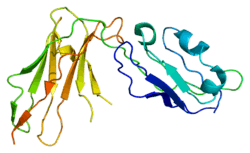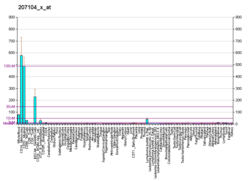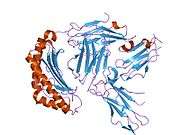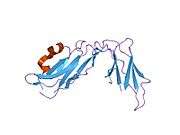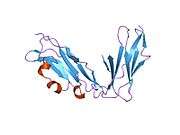LILRB1
Leukocyte immunoglobulin-like receptor subfamily B member 1 is a protein that in humans is encoded by the LILRB1 gene.[3][4]
Function
This gene is a member of the leukocyte immunoglobulin-like receptor (LIR) family, which is found in a gene cluster at chromosomal region 19q13.4. The encoded protein belongs to the subfamily B class of LIR receptors which contain two or four extracellular immunoglobulin domains, a transmembrane domain, and two to four cytoplasmic immunoreceptor tyrosine-based inhibitory motifs (ITIMs). The receptor is expressed on immune cells where it binds to MHC class I molecules on antigen-presenting cells and transduces a negative signal that inhibits stimulation of an immune response. It is thought to control inflammatory responses and cytotoxicity to help focus the immune response and limit autoreactivity. Multiple transcript variants encoding different isoforms have been found for this gene.[5]
See also
References
- ENSG00000276452, ENSG00000277134, ENSG00000274669, ENSG00000277807 GRCh38: Ensembl release 89: ENSG00000104972, ENSG00000276452, ENSG00000277134, ENSG00000274669, ENSG00000277807 - Ensembl, May 2017
- "Human PubMed Reference:". National Center for Biotechnology Information, U.S. National Library of Medicine.
- Cosman D, Fanger N, Borges L, Kubin M, Chin W, Peterson L, Hsu ML (Aug 1997). "A novel immunoglobulin superfamily receptor for cellular and viral MHC class I molecules". Immunity. 7 (2): 273–82. doi:10.1016/S1074-7613(00)80529-4. PMID 9285411.
- Colonna M, Navarro F, Bellón T, Llano M, García P, Samaridis J, Angman L, Cella M, López-Botet M (Dec 1997). "A common inhibitory receptor for major histocompatibility complex class I molecules on human lymphoid and myelomonocytic cells". The Journal of Experimental Medicine. 186 (11): 1809–18. doi:10.1084/jem.186.11.1809. PMC 2199153. PMID 9382880.
- "Entrez Gene: LILRB1 leukocyte immunoglobulin-like receptor, subfamily B (with TM and ITIM domains), member 1".
Further reading
- Maruyama K, Sugano S (Jan 1994). "Oligo-capping: a simple method to replace the cap structure of eukaryotic mRNAs with oligoribonucleotides". Gene. 138 (1–2): 171–4. doi:10.1016/0378-1119(94)90802-8. PMID 8125298.
- Hirohashi N, Nakao M, Kubo K, Yamada A, Shichijo S, Hara A, Sagawa K, Itoh K (Dec 1993). "A novel antigen (H47 Ag) on human lymphocytes involved in T cell activation". Cellular Immunology. 152 (2): 371–82. doi:10.1006/cimm.1993.1298. PMID 8258145.
- Samaridis J, Colonna M (Mar 1997). "Cloning of novel immunoglobulin superfamily receptors expressed on human myeloid and lymphoid cells: structural evidence for new stimulatory and inhibitory pathways". European Journal of Immunology. 27 (3): 660–5. doi:10.1002/eji.1830270313. PMID 9079806.
- Wagtmann N, Rojo S, Eichler E, Mohrenweiser H, Long EO (Aug 1997). "A new human gene complex encoding the killer cell inhibitory receptors and related monocyte/macrophage receptors". Current Biology. 7 (8): 615–8. doi:10.1016/S0960-9822(06)00263-6. PMID 9259559.
- Suzuki Y, Yoshitomo-Nakagawa K, Maruyama K, Suyama A, Sugano S (Oct 1997). "Construction and characterization of a full length-enriched and a 5'-end-enriched cDNA library". Gene. 200 (1–2): 149–56. doi:10.1016/S0378-1119(97)00411-3. PMID 9373149.
- Fanger NA, Cosman D, Peterson L, Braddy SC, Maliszewski CR, Borges L (Nov 1998). "The MHC class I binding proteins LIR-1 and LIR-2 inhibit Fc receptor-mediated signaling in monocytes". European Journal of Immunology. 28 (11): 3423–34. doi:10.1002/(SICI)1521-4141(199811)28:11<3423::AID-IMMU3423>3.0.CO;2-2. PMID 9842885.
- Navarro F, Llano M, Bellón T, Colonna M, Geraghty DE, López-Botet M (Jan 1999). "The ILT2(LIR1) and CD94/NKG2A NK cell receptors respectively recognize HLA-G1 and HLA-E molecules co-expressed on target cells". European Journal of Immunology. 29 (1): 277–83. doi:10.1002/(SICI)1521-4141(199901)29:01<277::AID-IMMU277>3.0.CO;2-4. PMID 9933109.
- Chapman TL, Heikeman AP, Bjorkman PJ (Nov 1999). "The inhibitory receptor LIR-1 uses a common binding interaction to recognize class I MHC molecules and the viral homolog UL18". Immunity. 11 (5): 603–13. doi:10.1016/S1074-7613(00)80135-1. PMID 10591185.
- Liu WR, Kim J, Nwankwo C, Ashworth LK, Arm JP (Jul 2000). "Genomic organization of the human leukocyte immunoglobulin-like receptors within the leukocyte receptor complex on chromosome 19q13.4". Immunogenetics. 51 (8–9): 659–69. doi:10.1007/s002510000183. PMID 10941837.
- Chapman TL, Heikema AP, West AP, Bjorkman PJ (Nov 2000). "Crystal structure and ligand binding properties of the D1D2 region of the inhibitory receptor LIR-1 (ILT2)". Immunity. 13 (5): 727–36. doi:10.1016/S1074-7613(00)00071-6. PMID 11114384.
- Lepin EJ, Bastin JM, Allan DS, Roncador G, Braud VM, Mason DY, van der Merwe PA, McMichael AJ, Bell JI, Powis SH, O'Callaghan CA (Dec 2000). "Functional characterization of HLA-F and binding of HLA-F tetramers to ILT2 and ILT4 receptors". European Journal of Immunology. 30 (12): 3552–61. doi:10.1002/1521-4141(200012)30:12<3552::AID-IMMU3552>3.0.CO;2-L. PMID 11169396.
- Young NT, Canavez F, Uhrberg M, Shum BP, Parham P (2001). "Conserved organization of the ILT/LIR gene family within the polymorphic human leukocyte receptor complex". Immunogenetics. 53 (4): 270–8. doi:10.1007/s002510100332. PMID 11491530.
- Saverino D, Merlo A, Bruno S, Pistoia V, Grossi CE, Ciccone E (Jan 2002). "Dual effect of CD85/leukocyte Ig-like receptor-1/Ig-like transcript 2 and CD152 (CTLA-4) on cytokine production by antigen-stimulated human T cells". Journal of Immunology. 168 (1): 207–15. doi:10.4049/jimmunol.168.1.207. PMID 11751964.
- Bellón T, Kitzig F, Sayós J, López-Botet M (Apr 2002). "Mutational analysis of immunoreceptor tyrosine-based inhibition motifs of the Ig-like transcript 2 (CD85j) leukocyte receptor". Journal of Immunology. 168 (7): 3351–9. doi:10.4049/jimmunol.168.7.3351. PMID 11907092.
- Nikolova M, Musette P, Bagot M, Boumsell L, Bensussan A (Aug 2002). "Engagement of ILT2/CD85j in Sézary syndrome cells inhibits their CD3/TCR signaling". Blood. 100 (3): 1019–25. doi:10.1182/blood-2001-12-0303. PMID 12130517.
- Willcox BE, Thomas LM, Chapman TL, Heikema AP, West AP, Bjorkman PJ (Oct 2002). "Crystal structure of LIR-2 (ILT4) at 1.8 A: differences from LIR-1 (ILT2) in regions implicated in the binding of the Human Cytomegalovirus class I MHC homolog UL18". BMC Structural Biology. 2: 6. doi:10.1186/1472-6807-2-6. PMC 130215. PMID 12390682.
- Achdout H, Arnon TI, Markel G, Gonen-Gross T, Katz G, Lieberman N, Gazit R, Joseph A, Kedar E, Mandelboim O (Jul 2003). "Enhanced recognition of human NK receptors after influenza virus infection". Journal of Immunology. 171 (2): 915–23. doi:10.4049/jimmunol.171.2.915. PMID 12847262.
External links
- LILRB1+protein,+human at the US National Library of Medicine Medical Subject Headings (MeSH)
This article incorporates text from the United States National Library of Medicine, which is in the public domain.
